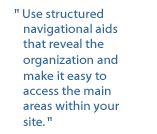 |
| General Principles |
 |
 |
 |
Make the site easy to navigate by making the structure readily apparent and using well organized a labeled navigational aids. |
 |
 |
 |
Reinforce and indicate to the user where they are currently located on the site. |
 |
 |
 |
Do not force a user into a dead-end page with no navigational options. |
 |
 |
 |
Help orient users who arrive within your web site (not through your home page) from external links, by making it easy for them to access the major categories/sections of your site. |
 |
 |
 |
Consider using a site map or index to provide a global view of available content and means to access it. |
 |
 |
 |
Where images and icons are used as links to additional information, make sure they readily suggest the underlying content viewers can expect to see, hear, etc. if they click on them. |
 |
| Consistency |
 |
 |
 |
Provide navigational aids at the top and bottom of each page. |
 |
 |
 |
Use recurring navigation aid (text/bar) on all pages to create a common navigational look and feel, and increase user control. |
 |
 |
 |
Make sure that recurring text or buttons appear in the same place on different pages. |
 |
| Metaphors |
 |
 |
 |
Navigational metaphors create meaningful contexts for relating known concepts. |
 |
 |
 |
Metaphors can help orient users by establising useful expectations about the site's organization and/or functionality. |
 |



